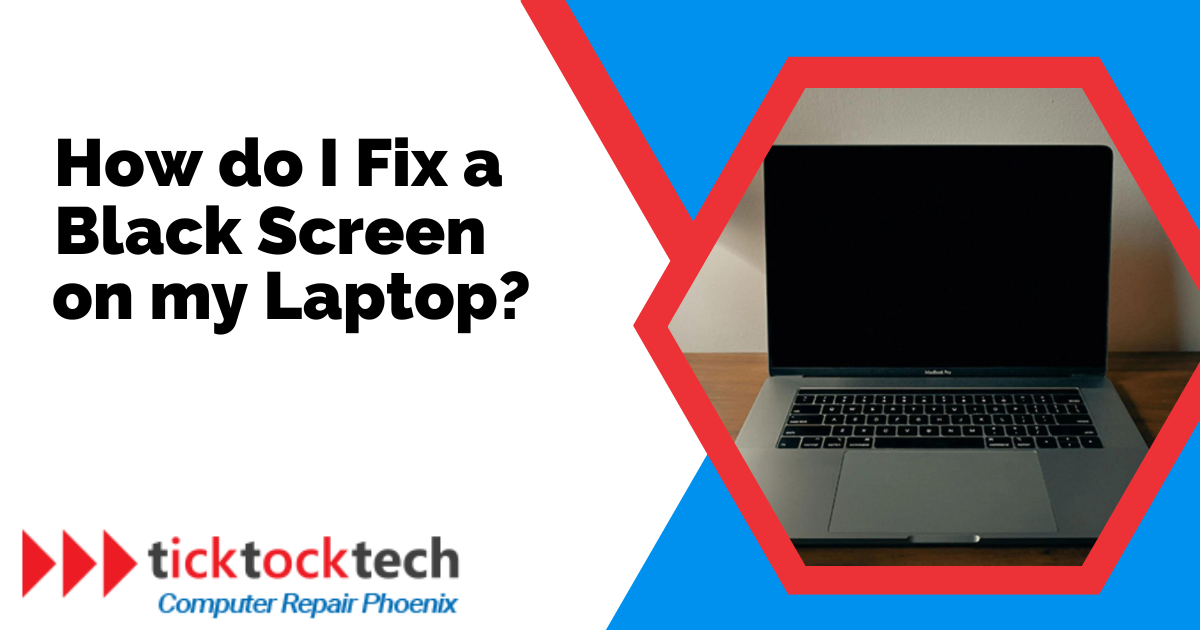Encountering computer problems is always a frustrating experience, but nothing beats the frustration of dealing with a black screen. If you are experiencing a black screen, there are different ways to resolve the issue. In this article, we’ll explore a range of solutions for tackling black screens on Windows and Mac laptops. However, before we dive into that, let’s check out the causes of a black screen.
Causes a black screen on a laptop (Windows & Mac)
Loose cable
If the cable that connects your laptop to an external monitor or display is not perfectly plugged in, it can result in a lack of display signal, leading to a black screen. Additionally, a faulty display cable can contribute to a black screen problem. Always ensure your cables are in perfect condition and properly plugged in to avoid this issue.
Software/Hardware Incompatibility
Another potential cause of a black screen on a laptop is software or hardware incompatibility. This can occur when you have recently upgraded to a new operating system version or when you have updated hardware components or firmware. These updates can cause compatibility issues or unresolved bugs resulting in a black screen. To tackle these issues, ensure that all apps are updated to their latest compatible versions before performing the OS upgrade. Also, check for compatibility issues or updates specific to your laptop model and hardware components before performing any update.
Faulty Driver
Display drivers aid communication between the operating system and the graphics hardware, enabling proper display functionality. If there is an issue with the display driver, it can result in a black screen. Sometimes, updating the display driver may lead to some complications, like causing a black screen. To address this, you may need to downgrade the display driver to a previous stable version.
Power Issues
Insufficient or fluctuating power supply can prevent your laptop from booting up and result in a black screen. This can be caused by factors such as; faulty adapters, damaged cables, or inadequate power from the power source. Always ensure your laptop is securely connected to a power source and the power adapter is properly plugged into the laptop and the power outlet.
Virus/Malware Infection
Malicious attacks can infiltrate your laptop’s operating system and cause disruptions. These malicious infections can modify system files or hijack display-related functions, leading to a black screen. Keep your antivirus software up to date for optimal protection against malware threats.
BIOS/UEFI Settings
The BIOS (Basic Input/Output System) and UEFI (Unified Extensible Firmware Interface) settings play a crucial role in the proper functioning of a laptop. Incorrect settings in the BIOS/UEFI firmware can lead to a black screen issue. To resolve this issue, you can restore the default settings or apply optimized defaults.
Related: How do I know if my laptop needs repair?
How to fix a black screen on Windows

Verify Power and Connections
One of the initial steps to address a black screen issue on Windows is to check the power and connections of your computer. Start by confirming that your computer is receiving power by checking the status of the power indicator lights. Ensure all cables connecting your computer to the monitor are securely plugged in at both ends.
Restart computer
A quick restart can fix a black screen on Windows. To restart your computer, locate the power button and press it. From the displayed menu, select the “Restart” option. In case the screen is completely black and you cannot see any visuals, you can try a forced shutdown by pressing and holding the power button until the computer turns off. Afterward, press the power button again to turn it back on.
Check display settings
Check the display settings and make sure they are configured correctly. You can access the display settings by right-clicking on the desktop and selecting either “Display settings” or “Screen resolution” from the menu.
Once you open the display settings, verify that the correct display is selected. If you have multiple monitors connected to your computer, ensure that the desired display is set as the primary monitor to send the video output to the correct screen.
Additionally, check the resolution settings and make sure they are suitable for your monitor. An incorrect resolution setting can cause display issues, including a black screen. Adjust the resolution if necessary to match the native resolution of your monitor or choose a resolution that works best for your needs. After making the changes, click “Apply” or “OK” to save the changes. The screen may flicker briefly as the settings are applied. If the black screen issue persists, restore the original display settings or experiment with different resolutions to find a suitable configuration for your system.
Boot into Safe Mode
Another method to resolve a black screen on Windows is to boot into Safe Mode, which allows you to troubleshoot and diagnose potential causes of the problem. To enter Safe Mode, restart your computer and press the F8 key repeatedly before the Windows logo appears. This will bring up the Advanced Boot Options menu.
From the Advanced Boot Options menu, choose the “Safe Mode” or “Safe Mode with Networking” option and press Enter. Safe Mode starts Windows with only the essential drivers and services needed for basic functionality, which can help identify and resolve issues. Once you’re in Safe Mode, you can perform different troubleshooting techniques. For example, you can uninstall recently installed apps that might be causing conflicts on your laptop. To do this, go to the Control Panel, open the “Programs” or “Programs and Features” section, and uninstall any recently added programs.
You can also update device drivers while in Safe Mode. Outdated or incompatible drivers can cause display issues. Open the Device Manager, locate the devices with driver issues (indicated by a yellow exclamation mark), right-click on them, and select “Update driver.” You can choose to update the driver automatically or manually by downloading the latest driver from the manufacturer’s website. After troubleshooting in Safe Mode, restart your computer normally to see if the black screen problem has been resolved.
Run System File Checker
Another method to address a black screen issue on Windows is through the System File Checker (SFC) tool. The SFC tool scans your system for corrupted or missing system files and attempts to repair them.
To run the System File Checker (SFC) tool, open the Command Prompt as an administrator by right-clicking on the Start button and selecting “Command Prompt (Admin)” or “Windows PowerShell (Admin).” In the Command Prompt window, type “sfc /scannow” (without quotes) and press Enter. This command will initiate the scanning process of your system files to check for any issues. Be patient and wait for the scan to complete, as it may take some time. The SFC tool will automatically scan your system files and attempt to repair any problems it finds. Once the scan is finished, you will see the scan results. If any issues are detected, the SFC tool will try to fix them automatically. Restart your computer after the scan and repair process to see if the black screen problem has been resolved.
System Restore
System Restore is a Windows feature to restore your computer to a previous point in time. It can be helpful in situations where you encounter issues such as a black screen after installing an application or making system changes.
To access System Restore, use the Advanced Boot Options menu or the Windows Recovery Environment, accessible by pressing F8 during boot or using Windows installation/recovery media. Choose the System Restore option, select a suitable restore point from the available list, and follow the on-screen instructions. Confirm your selection to initiate the restoration process, undoing recent system modifications. After completion, your computer will restart. Verify if the black screen problem has been resolved.
Reinstall Windows
If none of the previous methods have resolved the problem, reinstalling Windows might be the final solution. To reinstall Windows, you can follow two different methods. Each method provides a way to reinstall Windows based on different preferences. It is crucial to have a backup of all your files before you reinstall Windows, no matter which method you choose.
To reinstall Windows from the Settings menu, start by clicking the Start menu and selecting “Settings.” From there, navigate to “Update & security” and click on “Recovery.” Look for the “Reset this PC” option and click “Get started.” At this point, you can choose between two options: “Keep my files” to retain personal data or “Remove everything” to erase all data on the computer. Follow the on-screen instructions, and once you’re ready, click “Reset” to initiate the reinstallation process.
Alternatively, you can use the Windows installation media (such as a USB drive or DVD). For this method, you’ll need to download the Windows installation tool from the Microsoft software download site on a working computer. Once downloaded, run the tool and select “Create installation media.” Follow the prompts to create installation media on a USB flash drive or DVD. Afterward, connect the installation media to the computer where you want to reinstall Windows. Turn on the computer, ensuring it boots from the installation media. Select your language and other preferences, then click “Install now.” Follow the on-screen instructions to complete the reinstallation process.
Related: How to Repair or Fix MacBook
How to fix a black screen on Mac

Restart your MacBook
This is a simple but effective troubleshooting method to resolve a black screen. By restarting your MacBook, you are resetting its system and allowing it to start up fresh.
Restart your device by pressing Control + Command (the symbol with four loops) + Power/Eject/Touch ID button (depending on your MacBook Pro model). This key combination is designed to trigger an automatic restart of your device. Alternatively, you can also perform a manual restart by holding down the power button for approximately 5 seconds to shut down your MacBook. Afterward, wait about 15 seconds and press the power button again to reboot the laptop.
Check the power and brightness
When your Mac displays a black screen, it is important to check the power and brightness controls. While these simple factors are often overlooked, they can provide a simple solution.
Make sure that your Mac is connected to a power source. If you are running on battery power, connect your laptop to its charger to eliminate the possibility of a drained battery. Check the power indicator light on your MacBook to confirm a stable power connection. If the light is not illuminated, try a different power cable or outlet to rule out a faulty power cable. Adjust the brightness settings on your Mac. Ensure that neither you nor anyone else using the Mac has accidentally pressed the brightness keys on the keyboard. Press the F2 key or use the Control bar to increase brightness. Observe if the screen becomes visible as you adjust the brightness.
Even if you believe the battery has sufficient charge, it is advisable to connect your device to its charger when running on battery power. This will eliminate the possibility of a low battery causing the black screen issue.
Unplug accessories
Peripheral devices connected to your MacBook can sometimes interfere with the normal startup sequence, causing a black screen. By removing these devices, you can eliminate any potential conflicts or compatibility issues they may be causing. This applies to both wired and wireless peripherals.
To address this, carefully disconnect devices plugged into your MacBook’s ports. Unplug USB cables for printers and external drives. If you have a wired keyboard or mouse, detach them as well. Additionally, if you are using a wireless keyboard or trackpad, turn them off or remove their batteries.
Hard reset
Another method to fix a black screen on your MacBook is to try a hard restart, followed by starting up from macOS Recovery. A hard restart can sometimes resolve various MacBook issues effectively. To perform a hard restart, press and hold the power button for 10 seconds. This will force your MacBook to shut down. Release the power button, then immediately press and hold the Command (⌘) and R keys. Continue holding these keys until you see the macOS Recovery screen.
The macOS Recovery screen is a special mode that allows you to access certain recovery utilities, such as Disk Utility and macOS reinstallation. You can use these utilities to troubleshoot the black screen issue. For example, you can use Disk Utility to check for errors on your hard drive. If you find any errors, you can use Disk Utility to repair them.
Reset NVRAM
Resetting the NVRAM (non-volatile RAM) settings on Mac can be a helpful way to resolve a black screen. NVRAM stores important in-memory settings for different components such as hard drives, speakers, screen displays, and primary startup disks. Resetting the NVRAM can effectively restore these settings to their default values, potentially resolving any conflicts or errors related to the boot process.
To reset your Mac’s NVRAM settings, turn off your MacBook completely. Then, press the Power button to turn it back on. As your Mac begins to load, listen for the startup sound. Once you hear it, immediately press and hold the Command (⌘) + Option + P + R keys on your keyboard. Keep holding these keys until you hear the startup sound again, indicating that the NVRAM has been reset. Finally, release the keys and allow your Mac to continue starting up. By performing this NVRAM reset, you are restoring the system’s firmware settings to their default state, which can help resolve any configuration issues causing the black screen problem. Monitor your Mac after the reset to check if the black screen issue has been resolved.
Boot into Safe Mode
If you suspect that the black screen on your Mac is caused by corrupt information, you can try booting into Safe Mode as a troubleshooting step. This will initiate diagnostic checks on the startup disk during the boot process to resolve the problem.
To enter Safe Mode, power up or restart your Mac as usual, and immediately press and hold the Shift key until the Apple logo appears on the screen. Release the Shift key and allow the system to start up in Safe Mode. It may take longer than usual to boot as diagnostics are performed. To exit Safe Mode and return to normal startup, restart your Mac.
Reinstall macOS
If all other troubleshooting methods have failed to fix the black screen issue on your Mac, you may consider reinstalling macOS. Reinstalling macOS will restore your computer to its factory settings, similar to starting with a new Mac. However, it is possible to reinstall macOS without deleting your files. To do this, back up your files to an external hard drive or the cloud.
To reinstall macOS, start your Mac in macOS Recovery by holding down the Command and R keys as you start your Mac. In macOS Recovery, click Utilities > Disk Utility. In Disk Utility, select the startup disk and click First Aid. If First Aid finds any problems, allow it to repair them. Once First Aid is complete, close Disk Utility. In macOS Recovery, click Reinstall macOS and follow the on-screen instructions to reinstall macOS. After reinstalling macOS, restore your backed-up files. If you need help in the reinstallation process, contact Apple Support for further guidance and assistance.
FAQs on fixing a black screen on a laptop
If your screen goes black, you can try the following steps:
– Verify power and connections.
– Restart the computer.
– Check display settings.
– Boot into Safe Mode.
– Run System File Checker (Windows) or Disk Utility (Mac).
– Perform a system restore (Windows) or reinstall macOS (Mac).
A black screen on a laptop can be caused by:
– Loose cable connections or faulty display cables.
– Software or hardware incompatibility.
– Issues with the display driver.
– Power supply problems.
– Virus or malware infections.
– Incorrect BIOS/UEFI settings.
If your laptop screen is black but the keyboard is lit up, it could be due to a display-related issue.
– Some possible causes include:
– Faulty display hardware or connections.
– Incompatible or outdated display drivers.
– Incorrect display settings.
– Software or firmware conflicts.
Conclusion: How to fix a black screen on a laptop
To fix a black screen on your laptop, follow the different troubleshooting steps in the article. If the issue persists, perform a system restore or reinstall the operating system. Remember to back up your files before making changes and seek technical support when needed.

